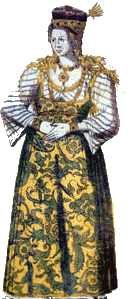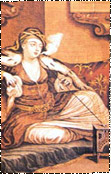| |

|
|

 |
5
OF 8 |
 |
OTTOMAN WOMEN
Kösem
 Princes
Ahmed and Mustafa lived together in the Golden Cage. When Ahmed
became sultan, he did not have the heart to murder his brother,
but he did keep Mustafa in the Cage-with just a few women. He built
a wall to block the entrance, leaving a small window through which
food was passed to Mustafa, as well as alcohol and opium. Fourteen
years later , this same wall was hammered down, and the utterly
demented Mustafa was declared sultan. Princes
Ahmed and Mustafa lived together in the Golden Cage. When Ahmed
became sultan, he did not have the heart to murder his brother,
but he did keep Mustafa in the Cage-with just a few women. He built
a wall to block the entrance, leaving a small window through which
food was passed to Mustafa, as well as alcohol and opium. Fourteen
years later , this same wall was hammered down, and the utterly
demented Mustafa was declared sultan.
His own years of isolation had created in Ahmed a void that çon(umed
continual diversion. He took a different woman to bed each night,
but he favored the Greek beauty Kösem, lavishing on her the finest
jewels from his hoard. Kösem was fifteen years old when she became
the favorite of fifteen- year-old Ahmed 1.
Ahmed ruled from 1603 to 1617, leaving Kösem
a young widow. Mustafa was released from the Cage, to become sultan,
while Kösem 's own sons, Murad, Beyazit, and Ibrahim, took his place
there. After only a few months, the crazed Mustafa was dethroned
by the eunuch corps, who did not favor him, and retumed to the Cage.
Mustafa's son Osman succeded him, but the young sultan fell victim
to the uprising of the janissaries and the sipahis (cavalry). Troops
marched into the Seraglio and dragged the sultan to the common Y
edikule (Seven Towers) prison. He was murdered, his ear cut off
and presented to his mother as an affront. Although fratricide was
common in the Ottoman Empire, this was the first act of regicide.
Once again, mad Mustafa was dragged out of the Cage (1622) and en-
throned. This time he ordered the execution ofKösem's sons. The
eunuch corps-again-intervened and crowned Kösem's oldest son as
Murad IV (1623-40). Thus Kösem attained her ambition of becoming
valide sultana. But Murad's cruelty disturbed her. He passed a law
prohibiting drinking and smoking throughout the empire, while he
himself abused both habits. He ordered the execution of anyone else
breaking this law .In a drunken stupor and accompanied by a mysterious
dervish, Murad wandered the streets incognito, searching for victims.
Corpses hung at every street corner. Kösem's youngest son, Ibrahim,
was also deranged.
 She
set her hopes on handsome, astute, and brave Beyazit, who was highly
skilled injousting. One day, Beyazit threw Murad off in a joust.
Shortly thereafter, while campaigning in Persia, Beyazit was killed
by order ofhis brother, an incident that later inspired Racine's
tragedy Bejazit.It was debauchery that brought about Murad's demise.
On his death- bed, he told his mother how much he disdained his
brother Ibrahim, and how it would be better for the dynasty to end
rather than continue with insane royal seed. He ordered Ibrahim's
death, but Kösem intervened, and Ibrahim was ordered out of the
Cage. He was too terrified to come out, convinced that his cruel
brother was playing a trick to torment him. He refused to leave
until Murad's corpse had been brought before him, and even then
Kösem had to coax him out as if cajoling a frightened kitten with
food. It was Ibrahim's reign (1640-48) that marked Kösem's real
power as valide. With the help of the grand vizier, Mustafa Pasha,
the empire was hers to rule. Feeble Ibrahim, entirely absorbed in
the joys of the harem, was being devoured by lust and debauchery.
The French called him ''Le Fou de' Fourrures'' because ofhis obsession
with furs; he wanted to touch, feel, and see furs everywhere in
the harem. He searched the empire for its fattest woman. She was
an Armenian, with whom he became madly infatuated, declaring her
the Govemor General of Damascus. Favored ladies were al- lowed to
take what they pleased from the bazaars. He made his sisters serve
the odalisques and presented his odalisques with the wealthiest
imperiaı estates. In a night of madness, he had his entire harem
put in sacks and drowned. She
set her hopes on handsome, astute, and brave Beyazit, who was highly
skilled injousting. One day, Beyazit threw Murad off in a joust.
Shortly thereafter, while campaigning in Persia, Beyazit was killed
by order ofhis brother, an incident that later inspired Racine's
tragedy Bejazit.It was debauchery that brought about Murad's demise.
On his death- bed, he told his mother how much he disdained his
brother Ibrahim, and how it would be better for the dynasty to end
rather than continue with insane royal seed. He ordered Ibrahim's
death, but Kösem intervened, and Ibrahim was ordered out of the
Cage. He was too terrified to come out, convinced that his cruel
brother was playing a trick to torment him. He refused to leave
until Murad's corpse had been brought before him, and even then
Kösem had to coax him out as if cajoling a frightened kitten with
food. It was Ibrahim's reign (1640-48) that marked Kösem's real
power as valide. With the help of the grand vizier, Mustafa Pasha,
the empire was hers to rule. Feeble Ibrahim, entirely absorbed in
the joys of the harem, was being devoured by lust and debauchery.
The French called him ''Le Fou de' Fourrures'' because ofhis obsession
with furs; he wanted to touch, feel, and see furs everywhere in
the harem. He searched the empire for its fattest woman. She was
an Armenian, with whom he became madly infatuated, declaring her
the Govemor General of Damascus. Favored ladies were al- lowed to
take what they pleased from the bazaars. He made his sisters serve
the odalisques and presented his odalisques with the wealthiest
imperiaı estates. In a night of madness, he had his entire harem
put in sacks and drowned.
 |
5
OF 8 |
 |
|
|


